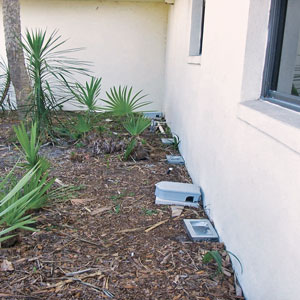
There were so many traps placed at this account, the spacing was unusually close. PHOTO: JUDY BLACK
BUILDING TYPE: Warehouse
LOCATION: Industrial area with outside food and haborage areas
THE HORRORS: Mass quantities of mice thanks to a freak natural breeding phenomeon, to the point where the crew was creating new ways to make the bait gravity-fed (yet still within the label constraints). Compounding the issue were the less-than-cooperative neighboring facilities.
Years ago, we had a large food processing facility with weekly service. The client was located between a non-food manufacturer on one side and a non-food-related shipping/warehousing facility on the other. There was a prominent drainage ditch, a street in front, and railroad tracks behind.
There were 100 exterior bait stations, and 70 multiple-catch traps protecting the interior. Rodent catches had been zero to negligible for years. All was well until the Great Mouse Invasion occurred.
In late August, we noticed a dramatic increase in activity on our bait stations and for the first time in years, began to trap mice inside the facility. We increased our service frequency to see what was going on, but it quickly became apparent that this was a mass influx of mice. Traps were added, at first gradually, then in mass numbers.
Obviously, this doesn’t happen without your client cooperating with you. They were not happy with the added expenditure, but clearly saw the data (and mice) as we did. Immediate action needed to be taken, as they could not afford to have an infestation within the production facility. The situation continued until January, however.
The interior remained static; we had a solid program there. As we added to the exterior program, we stopped catching mice within critical areas of the facility, but unbelievably, we still caught a few next to doors that were being left open by employees.
The exterior went from 100 to 300 bait stations, and it was all we could do to keep the bait supplied in these stations. We did not have any multiple-catch traps on the exterior when we started. We added 500. Again, we were filling up these traps on a regular basis.
We were trapping hundreds of mice on a regular basis. On our peak day, we trapped 482. I was sort of hoping for the milestone of 500, but the guys who worked there were not quite as excited about that as I was.

Judy Black
The original program gradually increased from an hour once a week to two hours every five days. The closest we got to what we thought would be optimal was 10 hours per day/seven days per week. However, we felt like six to eight hours per day would have been optimal at the peak. This would have allowed for two circuits during the day and one at night. The situation became so sensitive, though, that the client was really insisting on overkill. So, 10 hours daily was what we did.
We also contacted the neighboring facilities to see whether they would contract with us for service. They were less anxious to get involved, I think because they were non-food facilities. We contacted the county and the state. Our client even talked about trying to get a meeting with the governor.
The end result? Well, the state and county initially denied there was a problem. When the public began to get vocal, a task force was formed. The task force began baiting on public and private land in early December. The government investigation resulted in a conclusion that this was a “natural breeding process” and that there was nothing that could have been done to prevent it.
Because of the baiting in neighboring properties, we saw a decrease in mouse activity for our client. By February, the client was back to its original program, and we were extremely happy to not have to spend so much time out there.
Lessons learned: React quickly and aggressively when something is not normal. You have to allocate the right amount of resources; in this case, the material resources were the easy part, the labor resources were difficult to come by.
We could not have succeeded and responded so aggressively if the client didn’t trust us. They had gone so long without a problem, with a relatively static program, that they could have tried to throw blame around. We had a great relationship with them, and were able to review data and communicate well. They believed there was a problem that was out of our direct control, and that they could trust us to help them.
The involvement of the local government was essential to the resolution of this problem. Although we were not happy with the speed of their response, they eventually came through and really helped.
Leave A Comment